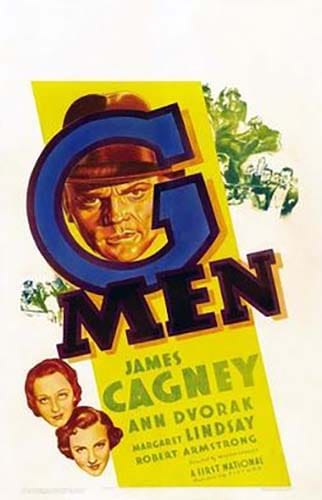G-man

To an American, a G-man is a federal law enforcement officer, and the G is generally taken to come from government, but this may not be the case. There is an earlier Irish use of G-man used to refer to police officers of the G Division, the detective division, of the Dublin Metropolitan Police. It may be that the American usage crossed the Atlantic with Irish immigrants, or it may be that the two usages are etymologically unrelated, arising separately on each side of the ocean. Militating against the Irish connection is that in American usage G-men have always been federal agents, originally treasury agents charged with enforcing Prohibition, not ordinary police detectives.
The G Division of the Dublin police was formed in 1842. Divisions A–F were uniformed divisions patrolling various districts of the city, and the G Division were the detectives. Quickly, however, the G Division assumed responsibility for monitoring and suppressing republican political activities, that is, to say in the parlance of the day, Fenianism.
The earliest use of G-men that I have found, however, refers to ordinary police work. From Dublin’s Freeman’s Journal of 2 September 1872:
A few months ago our city was honoured with a short sojourn of a notorious gang of garotters [sic], whose desperate attacks upon citizens awakened a feeling akin to dread in those whose business required them to be in the streets after nightfall. Thanks to the energetic efforts of our efficient detective force, the depredations of these ruffians were but few; and the G men of Exchange Court—the Scotland Yard of Dublin—daily placed in the dock powerfully-built men of the worst type of English criminals.
A use of G-men in relation to suppressing political activities comes in an 1881 autobiography (published anonymously) of republican activist Michael Davitt:
Detective officer Sheridan was directed by his Chief to go over to the Land League offices, in Sackville Street, and tell Davitt that he was wanted in the Lower Castle Yard. Sheridan, at an interval, was followed by half a dozen “G men,” as the occupants of Exchange Court are called in the newspapers, and he confronted Davitt in company with Messrs. Harris and Brennan, two of the traversers in the recent State Trial, upon O’Connell Bridge.
And there is this delightfully written account of a G-man staking out the home of politician and activist John Dillon in Freeman’s Journal of 16 April 1888:
Early on Saturday a detective was posted at the top of North Great George’s-street, and he planted himself with his back to the railings of Belvidere College, where he could command a view of Mr. Dillon’s front door. He was very artistically dressed as an ordinary citizen, but “gave himself away” badly with his gloves and umbrella—no man built to baton Nationalists ever looks quite at home with Supple’s No 9 on his paws, and one of Smyth’s silk alpaca rain-protectors under his arm. He sauntered at intervals up and down the street, then he perused Tit Bits until the third edition of the Evening Telegraph was on sale; as time went on the “last edition” arrived and he again invested, and before he went off duty he had squandered the money of the ratepayers on an “extra.” About 6 o’clock Sergeant 13 C and Constables 94 C and 193 C took up their posts opposite the G man, at whom they stared with a “don’t-know-yer” air that was quite delightful.
American use of G-man can be traced to 1928, referring to U.S. Treasury agents charged with enforcing Prohibition. The earliest use I have found is in a 28 October 1928 Associated Press report of the affairs of Mary Louise Cecilia “Texas” Guinan (1884–1933), an actress and owner of a number of speakeasys. The report uses the term, crediting it to night club slang:
Miss Guinan, stopping over en route to New York where she has an engagement Monday with the “G” men (night club for federal prohibition agents), was moved into invective against California by dispatches lastnight [sic]. These dispatches quoted Marie Prevost of the films as saying Miss Guinan left Hollywood suddenly without paying $800 for a month’s rent of Mis Prevost’s bungalow.
(The character of Guinan on the television series Star Trek: The Next Generation is named for Texas Guinan. On the show, Guinan runs the lounge on the starship Enterprise.)
There is a popular myth that G-man was coined on 26 September 1933 by George Kelly Barnes, a.k.a. Machine Gun Kelly. He allegedly said, “Don’t shoot, G-men! Don’t shoot!” as he was being arrested by FBI agents. Kelly may or may not have uttered those words, but he clearly was not the originator of the term.
So is G-man an Irish import or an all-American term? For the moment, at least, we don’t have enough evidence to say one way or the other.
Sources:
Associated Press. “California Boosters Will Not Be Able to Use ‘Texas Stuff.’” Arkansas Gazette (Little Rock), 28 October 1928, 1/4. Readex: America’s Historical Newspapers.
Bauerle, Richard F. “Origin of ‘G-Man.’” American Speech, 32.3, October 1957, 232–33. JSTOR.
Davitt, Michael. Davitt’s Life: In Sunshine and Shade. Dublin: W. J. Alley, 1881, 13. Gale Primary Sources: The Making of the Modern World.
Dobbie, Elliott, V. K. “Did ‘G-man’ Come from Ireland?” American Speech, 32.4, December 1957, 306-307. JSTOR.
“Mr. John Dillon and the Police.” Freeman’s Journal (Dublin), 16 April 1888, 5/4. Gale Primary Sources: British Library Newspapers.
Oxford English Dictionary, second edition, 1989, s.v. G-man, n.
“To All Whom It May Concern.” Freeman’s Journal (Dublin), 2 September 1872, 7/6. Gale Primary Sources: British Library Newspapers.
Image credit: Warner Bros. Pictures, 1935. Wikipedia. Fair use of a low-resolution copy of the poster to illustrate the topic under discussion.